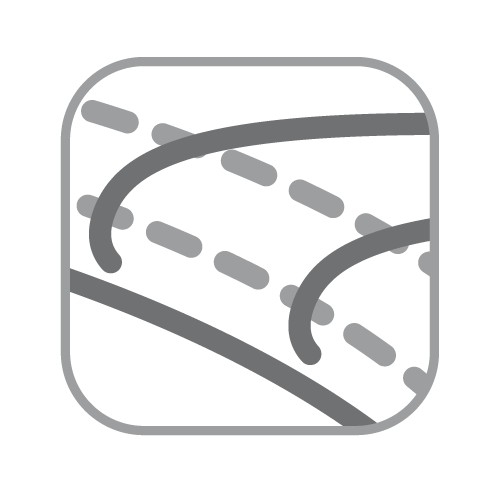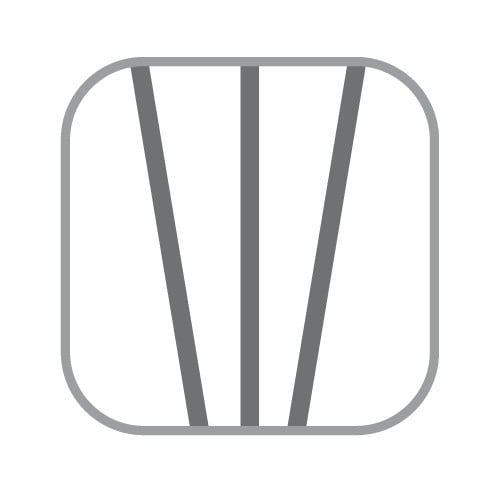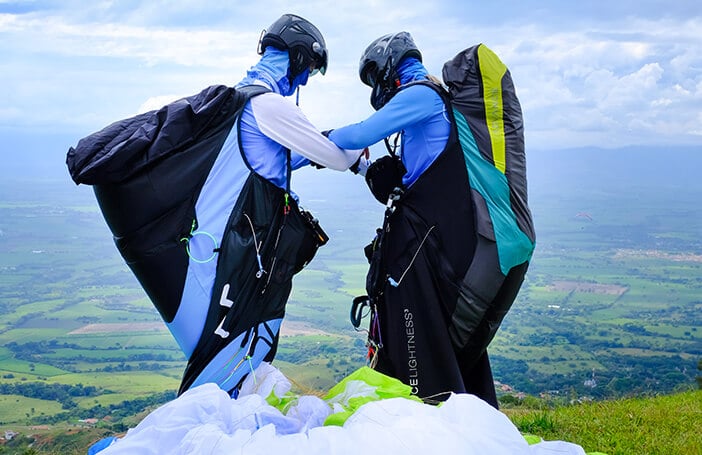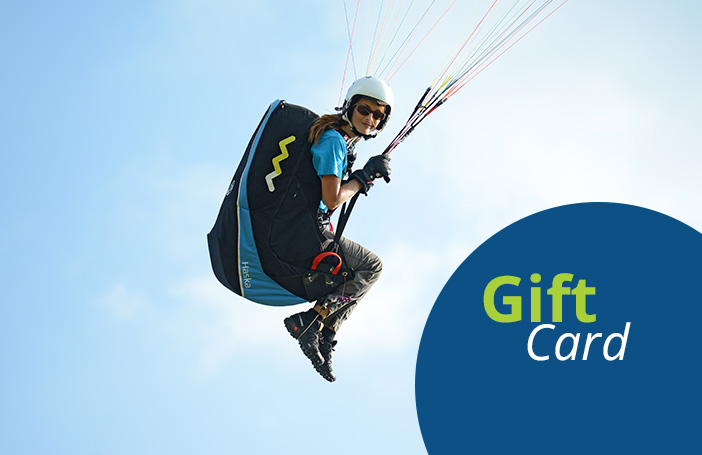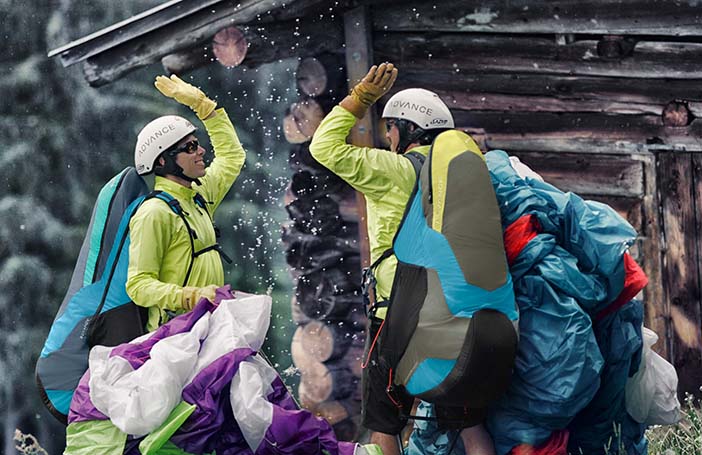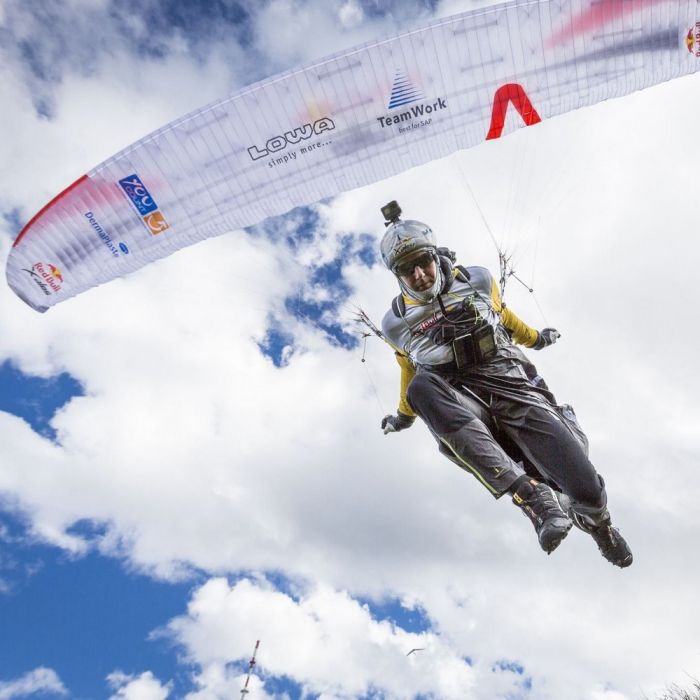
Skywalk X-ALPS 3 (PAST MODEL)
Select all options to view stock availability

Superseded by the Skywalk X-ALPS4.
THE ultra-lightweight comp wing for YOUR ultimate Hike & Fly race. Superseded by X-ALPS4
When every gram counts.
The X-ALPS3 was developed for Hike&Fly pilots who want to reach the maximum in the world’s most demanding competitions. Its radically low-weight construction provides the basis for success when every gram counts. Chrigel Maurer, Paul Guschlbauer, Simon Oberrauner and Ferdy van Schelven demonstrated this impressively in the Red Bull X-Alps 2017, garnering four of the five top places.
The concept is based on the POISON X-ALPS. Although the POISON itself is already lightweight, the skywalk R&D team was able to reduce its weight by an additional 600 grams.
"The X-ALPS3 represents what is currently possible in lightweight construction when it comes to absolute top performance,” says Stephan Gruber about his current wing. The skywalk R&D team member played a key role in the development of the X-ALPS3 and qualified for the Red Bull X-Alps for the second time in 2017. "We succeeded in translating the complex cell construction of the POISON into a new lightweight construction concept. We threw every component on the scales and reduced the weight of the POISON by an additional 20 percent through the use of new materials in the sails and consequent material reduction in the profile ribs and risers – all without changing its flying characteristics. Performance, handling and safety are identical to the POISON. Maybe even a bit better,” laughs Stephan Gruber.
The X-ALPS3 is available in three sizes perfectly tailored to the launch weight of Hike&Fly pilots.
HOW DOES THE X-ALPS GLIDE?
The X-ALPS3 glides as if on rails, smooths out even the smallest bumps, and uncompromisingly converts every little bit of lift into altitude. Its optimally selected aspect ratio of 6.9 guarantees comp wing feeling.
Thanks to its 3-line technology, it is amazingly easy to launch despite its high A/R and is easy to fly, even when conditions get rough. The "Speed Control” system helps take care of that. This system modifies not only the C-, but also the B-line geometry of this 3-liner and its comfortable handles make it feel intuitive. The Speed Control prevents profile deformations and surges that degrade performance. Combined with the smooth speed system, the Speed Control enables efficient and fatigue-free flying on bar – whether scratching down low or sailing along under an endless cloud street.
Thanks to its high stability, the X-ALPS3 is very resistant to collapses. Line pressure on its short brake line travel increases continuously and markedly, giving pilots flying in rough air optimal feedback. For experienced pilots who fly very actively, gliders reactions remain manageable. However, Skywalk recommend the X-ALPS3 only for pilots who already have experience with gliders of this class under turbulent conditions and who are experienced in recovering from extreme flight maneuvers.
Features

JET FLAPS
Our JET FLAPS extend the green arc as you approach the stall point, which substantially increases safety and also improves climb performance.

C-WIRES
C-wires are nylon wires sewn into the glider over the anchor points of the C-level lines. Advantages: better load distribution, reduced drag, more performance.

MINI RIBS
Doubling the number of cells at the trailing edge increases its shape stability substantially. Advantage: fewer vortices improve the aerodynamics and with it the performance.
RIGID FOIL
The Rigid Foil nylon wires on the leading edge help maintain its shape and ensure constant ram air pressure. Advantages: better takeoff behavior, more performance and lower canopy weight.
3D-SHAPING
A precise calculation of the leading edge geometry and the installation of an additional strip of fabric reduce wrinkling in this sensitive part of the glider. Advantages: exact wing shape, more performance.
3 LINE LEVELS
The 3-line-level concept reduces the number of lines and the resulting drag. Advantages: more performance and a better overview at launch.
SHARK NOSE
Together with a corresponding wing design, the shark nose technology improves pressure distribution in the canopy substantially. Advantages: much more solid flying feeling and substantial performance gain, especially when gliding on bar.
SPEED CONTROL HANDLE
Handle on rear riser which allows the pilot to even out turbulence, speed and pitch while flying on speed bar without having to release the speed bar.
Differences to previous model (X-ALPS2)
Launch
A little bit easier than the POISON X-ALPS; Line sorting requires a little attention (brake lines are very thin); forward launch with arms held parallel and continous pull on the A-risers; reverse launch with inside A-risers
Handling
A little bit more agile than POISON X-ALPS due to lighter canopy; short and precise brake line travel; stall is abrupt, good steering-ergonomic; bank angle is easy to vary
Thermals
Like POISON X-ALPS; Wingtips are very stable; very efficient climb behavior
Performance
Like POISON X-ALPS; high performance (at trim speed and on bar; especially in turbulent air); very stable on bar; high trim and max. speed due to high wing loading; innovative C-riser steering; smooth speed bar
Extreme flight maneuvers
Like POISON X-ALPS; front and side collapses with collapse lines
Technical Differences
Based on POISON X-ALPS; lighter materials; Dyneema-risers; details modified;
Note: The sizes XXS and S are not identical with the sizes of the POISON XALPS - see weight range table below.
Target group
XC and comp pilots; highly suitable for Bordairline and X-Alps competitions (due to low weight)
Demands on pilot
For pilots with a lot of experience in recovering from unusual attitudes, who fly very actively, who have significant experience flying in turbulent conditions, and who accept the possible consequences of flying such a paraglider
Comparable competing models
Ozone LM6, Air Design Hero; Niviuk Klimber P; Advance Omega X-Alps2; Gin GTO2
Risers
6mm Dyneema
Brake handles
Material like HIKE-brake handles; without swivel; without velcro or snap; brake handle is attached to a rubber ring
Technical Data
Size
| Size | XXS | XS | S |
|---|---|---|---|
| Certification LTF/EN | D* | D* | D* |
| Certified weight range (kg) LTF/EN | 65 – 85 | 70 – 90 | 80 – 95 |
| Recommended weight range (kg) | 73 – 82 | 77 – 87 | 86 – 93 |
| Cells | 80 | 80 | 80 |
| Area flat (m²) | 20.50 | 21.50 | 22.40 |
| Area projected (m²) | 17.67 | 18.54 | 19.30 |
| Wingspan flat (m) | 11.98 | 12.27 | 12.57 |
| Wingspan projected (m) | 9.77 | 10.00 | 10.21 |
| Aspect ratio flat | 6.99 | 6.99 | 6.99 |
| Aspect ratio projected | 5.40 | 5.40 | 5.40 |
| Glider weight (kg) | 3.3 | 3.4 | 3.5 |
| Certified weight range (kg) | 65 – 85 | 70 – 90 | 80 – 95 |
* with colapse lines
Material
| Upper sail | Porcher Skytex 27g |
| Lower sail | Porcher Skytex 27g |
| Ribs | Porcher Skytex 27g hard |
| Bands | Porcher Skytex 27g hard |
| Main lines | Edelrid 8000 U-230 / U-190 / U-90 |
| Middle lines | Edelrid 8000 U-90 / U-50, Liros DC60 |
| Top lines | Edelrid 8000 U-50 / 9200-30 |
| Brake lines | Liros PPSL160 / DC60, Edelrid 9200-30 |
| Riser | Liros 6mm Dyneema |
DOWNLOADS
X-ALPS3 manual including line plan
Your X-ALPS3 package
The ultralight performance wing X-ALPS3 comes with
- Backpack
- Compression strap
- Innerbag
- Riser bag
- Manual
- Bandana
- Repair Kit
Pilot Quotes
The ease and safety of the 3-Line-Concept allowed me to defend my title without stress…
- The Champion, Chrigel Maurer
Under the X-ALPS3 I felt comfortable, even in risky situations. That opened the doors to take extraordinary routes and become 3rd place sovereignly for the third time.
- The Adventurer, Paul Guschlbauer
With the necessary performance of the X-ALPS3 I could finally achieve a result in the top five!
- The Routine, Ferdy van Shelven
I just had serious fun flying skywalks X-ALPS3 wing during the competition. To get a spot in the top 5 makes a dream come true for me.
- The Rookie, Simon Oberrauner
FAQs
Is the deterioration on light-cloths higher than on a regular glider cloth?
Light-cloths are thinner than conventional glider-cloths and therefore less resistant against mechanical strain. That means you need to pay more attention on small rocks and bushes. Please avoid any unnecessary contact to the ground. With this strict observance you will have the same durability as with a conventional glider-cloth.
What are the glide ratio (L/D), trim and maximum speeds?
Skywalk know that this data is interesting for you as a pilot, but for Skywalk to publish them would be a bad idea for the following reasons:
- Performance data are highly dependent on the drag of the pilot and are therefore related to sitting position and harness. The difference between aerodynamically favorable and unfavorable harnesses and sitting positions can be as much as a whole L/D number.
- Performance increases with the size of the glider. A large glider will always outperform the same glider in a smaller size. So a question about the performance of a glider is always also a question about the size.
- There is no normed method of testing the performance of paragliders. For example, speed varies with altitude and the associated different air pressure, but also with the total weight of the system.
That means that there simply isn’t THE speed or THE L/D that would allow a serious comparison with another glider. Performance data are dependent on the harness, the size of the glider, on the air mass and the total weight.
How do I calculate my takeoff weight?
Takeoff weight is calculated by adding the weight of the pilot including clothes to the weight of the equipment. The equipment consists of the harness, the reserve chute, the paraglider itself, and any flight instruments and other baggage you may carry (e.g. rucksack, etc.).
Is it OK for me to shorten the brake lines on my skywalk paraglider?
Changing the length of the brake lines can have a negative effect on the flying characteristics and extreme flight behavior. The paraglider needs a little more lead when flying on speed bar, otherwise the glider could be braked unintentionally, leading to a loss of performance. When performig extreme flying maneuvers, shortening the brake lines too much can cause complications during recovery from collapses, parachutal stall, etc.
Am I allowed to make modifciations to my skywalk paraglider?
No, because the glider is certified the way it is delivered to you. Even the brake line length is part of the trim and must not be changed.
What are JetFlaps and how do they work?
Jet Flaps are a so-called split flap like those seen on a large airplane. When the glider is braked, the airflow is routed through the glider, restoring smooth airflow. This extends brake line travel and softens the stall behavior.
What advantage do the JetFlaps on my skywalk paraglider offer?
Lower flyable minimum airspeed. The speed range is wider and easier to control. The pilot has more time to react when flying near the stall point.
| Condition | New |
|---|---|
| EN Certification | EN D |
| LTF Certification | LTF D |
| Model Status | Past model |
Standard UK delivery - £3.95 / FREE on orders over £100.
Outside the UK - delivery calculated at checkout (based on the total order value and your delivery address).
We use Royal Mail, Parcelforce Worldwide and other courier companies (e.g. DHL, DPD) depending on shipment value, weight, destination etc.
For more information, please view our order and delivery FAQs page.
If you are not 100% satisfied with your order, you have 14 days from the day of delivery to request a refund.
Delivery costs will not be refunded and you will be responsible for the delivery cost to return the order.
For more information, please read our returns and exchanges policy.


